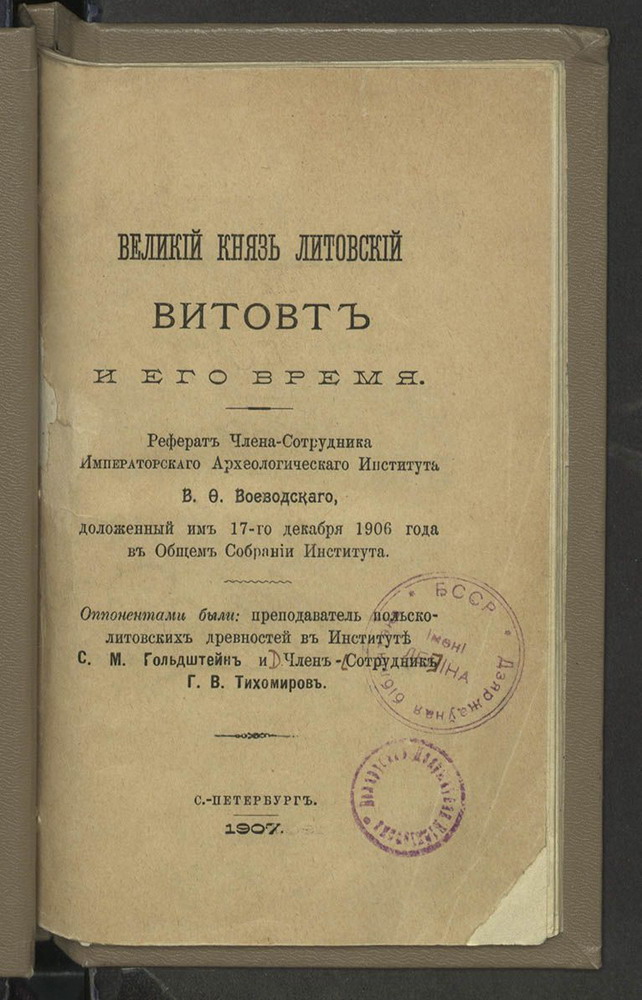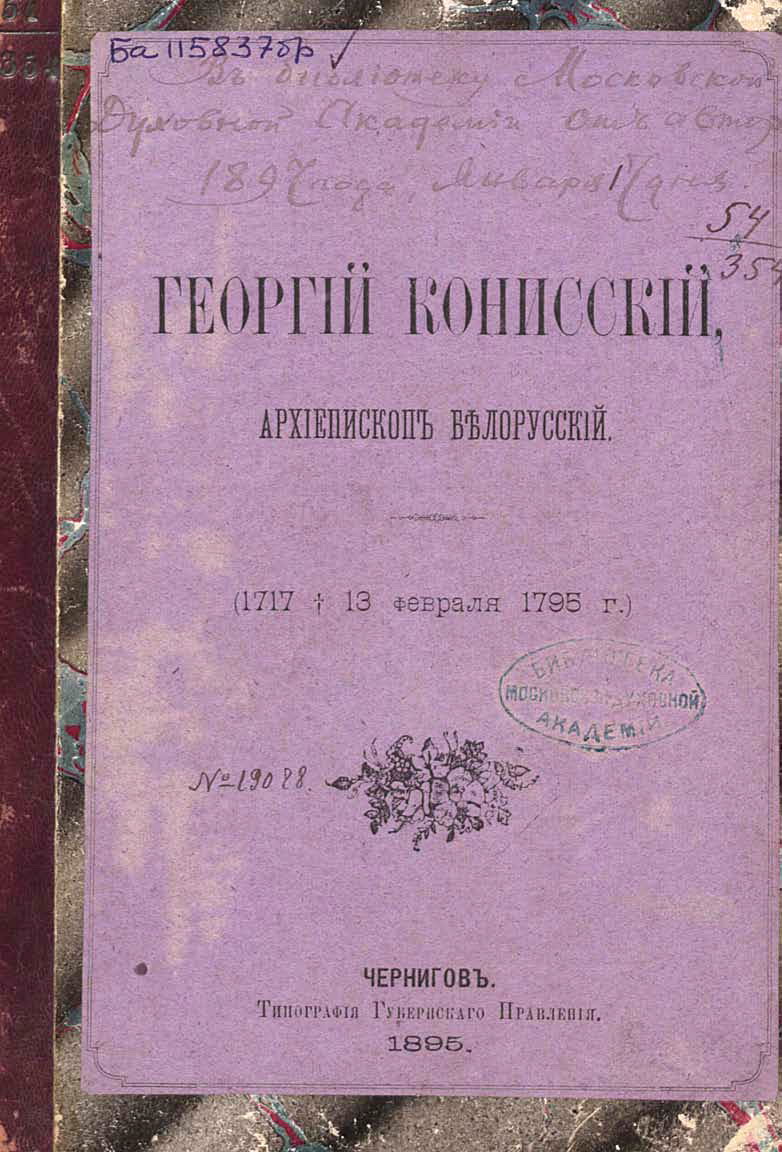Outstanding people
|
ВЫДАЮЩИЕСЯ ЛИЧНОСТИ |
|

|
Title: Великий князь литовский Витовт и его время. Author: Voevodsky F. Vitold. Place and date of issue: Saint Petersburg: Губернская типография, 1907. Annotation: Vitold F. Voevodsky was a historian, expert of the Imperial Archaeological Institute. Vytautas, the Grand Duke of Lithuania, was one of the most prominent rulers of the Grand Duchy of Lithuania. In his lifetime he was called “The Great”. The edition contains a description of the life of this outstanding ruler and military leader. |
|
OUTSTANDING PEOPLE |
|
 |
Title: Георгий Конисский. Author: Iv. Minkevich. Place and date of issue: Чернигов : Типография Губернского правления, 1895. Annotation: George (Konissky, Grigory Osipovich; archbishop of Mogilev, Mstislavsky and Orshansky; 1717–1795) is an Ukrainian and Belarusian church and a public figure and writer. He fought for the preservation and revival of Orthodoxy in Belarus. Since 1744 he was in monasticism, and since 1755 he was a Bishop of Mogilev (or Belarusian). After a long break he became the first Orthodox bishop in the Polish-Lithuanian Commonwealth. Since 1772 he was a Bishop of Mogilev, Mstislavl and Orsha, an Archbishop since 1783. He wrote the well-known “Notes on the time of the Union appearance”, “Notes on the Mogilev Seminary,” and others. |

|
Title: Доктор Франциск Скорина : его переводы, печатные издания и язык. Author: Владимиров, Петр Владимирович. Place and date of issue: [Санкт-Петербург] : Типография Императорской академии наук, 1888. Annotation: The work of Russian literary historian and specialist in Slavonic studies P.V. Vladimirov (1854-1914) is devoted to Belarusian and East Slavonic first printer, writer, translator, educator and humanist of the Renaissance – Francisk Skorina (circa 1490–1551). This is the first comprehensive study of Skorina’s life and career against the background of the history of the Grand Duchy of Lithuania in the early XVI century. |

|
Title: У трохсотыя ўгодкі смерці вялікага канцлера Льва Сапегі. Author: Шкялёнак, М. Place and date of issue: Вільня : (Друкарня Я. Левіна), 1933. Annotation: This book is the first in Belarusian historiography monograph on the life and career of Lew Sapieha (1557–1633) – political, public and military figure of the Grand Duchy of Lithuania (GDL); diplomat, thinker and strategist originating from the noble magnate-princely family. Lew Sapieha had part in creation of the Tribunal (the Supreme Court of the Grand Duchy of Lithuania) in 1581, and in preparation and publication of the Statute of GDL in 1588. Lew Sapieha’s philosophical and legal knowledge and beliefs had significantly influenced the content of the Statute – the most perfect code of laws in medieval Europe, the classical model of feudal law that was in force in the Belarusian land until 1840. |

|
Place and date of issue: Санкт-Петербург : Синод. тип., 1841.
Annotation: Evfrosinia Polotskaya is regarded as the heavenly patroness of Belarus. She was born circa 1101 (not later than 1104) in the family of prince Svyatoslav-Georgi, the younger son of Vseslav Charodey (Vseslav the Sorcerer). The princess secretly took the veil under the name of Evfrosinia. |

|
Title: Небесные беги. Author: Дроздович, Язеп Нарцизович. Place and date of issue: Вильно : Тип. А. Дворжеца, 1931.
Annotation: Yazep Drozdovich went down in the history of Belarusian culture as a man of many talents: artist, sculptor, ethnographer, archeologist, teacher, and one of the founders of national historical painting. Yazep Drozdovich was known as The Belarusian Leonardo Da Vinci, The Belarusian Tsiolkovsky. |

|
Title: А.П. Сапунов : к 25-летию его ученой и литературной деятельности. Author: Стукалич, Владимир Казимирович. Place and date of issue: Витебск : Губернская типолитография, 1905.
Annotation: The monograph of V.K. Stukalich (1858–1918), the historian, regional ethnographer and literary critic, is dedicated to the 25th year of scientific and literary activities of Aleksey Sapunov (1851–1924) who studied the history, literature, ethnography, archeology, architecture and folklore of Belarus, mainly the Trans-Dvina Region. The book features a brief biographical essay and a detailed description of the scientific papers of the outstanding scientist who became, according to M.V. Dovnar-Zapolsky, “the pioneer of provincial science”. |

|
Title: Иван Иванович Носович : (краткий биографический очерк). Author: Шейн, Павел Васильевич. Place and year of issue: Санкт-Петербург : Типография Императорской Академии наук, 1900. Annotation: The book of well-known Belarusian ethnographer and folklorist P. Sheyn (1826–1900) is devoted to the life and work of outstanding Belarusian linguist, lexicographer, ethnographer, folklorist, teacher, poet, translator and public figure, a man of great erudition, polyglot Ivan Nosovich (1788–1877). |

|
Title: Прафесар Браніслаў Эпімах-Шыпіла : З яго жыцця і працы. Author: Stankevich, Adam. Place and yea of issue: Vilna, 1935. Annotation: The book contains an overview of the life and work of the Belarusian culture figure, publisher, folklorist and linguist Bronislav Epimakh-Shipilo (1859–1934) who has played a great role in the development of language, literature and culture of Belarus at the end of the 19th century and the beginning of the 20th century. |

|
Title: Author: Golubok, Vladimir. Place and year of issue: Minsk, 1929. Annotation: Vladislav Golubok (1882–1937) is one of the leading theatrical figures; he has combined the talent of the writer and the playwright, the actor and the director, the artist and the musician, the teacher of artistic youth and the theatre manager. Vladislav Golubok was first who was awarded the rank of the People’s Actor of Belarus (1928). |

|
Title: Полацкі князь Усяслаў – беларускі нацыянальны асілак. Author: Sakharov, Sergei. Place and year of issue: Vilna, 1939.
Annotation: The book is dedicated to Vseslav of Polotsk or Vseslav the Sorcerer (about 1029–1101). A long, more than semi-centennial reign of Vseslav the Sorcerer was the period of the creation of a territorial, political and ethno-cultural basis for the future Belarus, an economic and political blossoming of the Polotsk lands and the development of the city as a trading and cultural center. |

